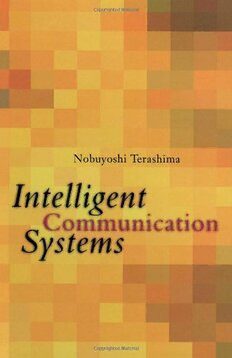Table Of ContentINTELLIGENT COMMUNICATION SYSTEMS
This page intentionally left blank
INTELLIGENT
COMMUNICATION
SYSTEMS
Nobuyoshi Terashima
Graduate School of Global Information
and Telecommunication Studies
Waseda University
Tokyo, Japan
ACADEMIC PRESS
A Harcourt Science and Technology Company
San Diego San Francisco New York Boston
London Sydney Tokyo
This book is printed on acid-free paper. ©
Copyright © 2002 by Academic Press
All rights reserved.
No part of this publication may be reproduced or transmitted in any form or by
any means, electronic or mechanical, including photocopy, recording, or any
information storage and retrieval system, without permission in writing from the
publisher.
Requests for permission to make copies of any part of the work should be mailed
to: Permissions Department, Harcourt, Inc., 6277 Sea Harbor Drive, Orlando,
Florida 32887-6777.
These materials were previously published in Japanese under the title of
The Intelligent Communication System: Toward Constructing Human Friendly
Communication Environments.
ACADEMIC PRESS
A division of Harcourt, Inc.
525 B Street, Suite 1900, San Diego, California 92101-4495, USA
http://www.academicpress.com
Academic Press
Harcourt Place, 32 Jamestown Road, London NW1 7BY, UK
http://www.academicpress.com
Library of Congress Catalog Card Number: 2001091273
International Standard Book Number: 0-12-685351-7
Printed in the United States of America
01 02 03 04 05 06 ML 9 8 7 6 5 4 3 2 1
CONTENTS
Preface ix
Author's Note xiii
I Information Technology I
1.1 Information Technology Concept 2
1.2 Intelligent Network Concept 5
2 Comunication Fundamentals 7
2.1 Connection-type Communication and Connectionless-type
Communication 7
2.2 Numbering Plan 10
2.3 Protocol 10
v
Vi INTELLIGENT COMMUNICATION SYSTEMS
3 Communication Network Structure 13
3.1 Telephone Network Architecture 13
3.2 Computer Network Architecture 14
3.3 Internet Network Architecture 20
4 Advances in Communication Networks 23
4.1 Integrated Services Digital Network 24
4.2 N-ISDN 24
4.3 B-ISDN 25
4.4 Asynchronous Transfer Mode 26
5 A Variety of Telecommunication Systems 37
5.1 Computer Sharing 37
5.2 Facsimile Communication System 38
5.3 Videotex Communication System 38
5.4 Distance Education System 40
6 Information Superhighways 45
6.1 The Gigabit Network Test Bed Project 46
6.2 Super-High-Speed Backbone Network Project 47
6.3 Internet 2 and the Next-Generation Internet 48
6.4 Global Information Infrastructure 48
6.5 Significance of Information Superhighways 49
7 Newly Developed Telecommunication Services 51
7.1 Toll-Free-Phone Service 52
7.2 Caller ID Service 52
7.3 Call Forwarding Service 53
7.4 Call Waiting Service 53
7.5 Mobile Communication Service 53
7.6 The Internet 56
7.7 Intranet 67
7.8 Continuous Acquisition and Lifelong Support 69
7.9 Electronic Money 74
CONTENTS Vii
8 Intelligent Communication Systems 79
8.1 Concept of Intelligent Communication Systems 80
8.2 Functions of the Intelligent Processing Layer 80
8.3 Structure of the Knowledge-Base System 81
9 Design Methodology for Telecommunication
Services 85
9.1 State-of-the-Art Design Methodology 85
9.2 Definitions 88
9.3 Graph Theory 89
9.4 Example Description of Telecommunication Services 92
9.5 Conflicts Among Telecommunication Services 95
9.6 Conflict of Charge Policy 97
9.7 High-Level Description of Telecommunication Services 98
9.8 Requirement Specification 101
10 Basic Technology of the Intelligent Communication
System 103
10.1 Application of Production Rules to Telecommunications 104
10.2 Description of Telecommunication Services in a
Semantic Network 108
10.3 Symbolic Logic 110
10.4 Predicate Logic 114
I I Telesensation 127
11.1 Virtual Reality Concept 127
11.2 History of Virtual Reality 129
11.3 Virtual Object Handling 130
11.4 Examples of Virtual Reality 130
11.5 Applications of Virtual Reality 131
11.6 Telesensation 132
11.7 Types of Telesensation 132
11.8 HyperReality 136
11.9 Possible Applications of HyperReality 139
11.10 Technologies for Establishing HyperReality 148
VIII INTELLIGENT COMMUNICATION SYSTEMS
12 Computer Vision 149
12.1 Definitions 149
12.2 Image Display 151
12.3 Image Transformation 155
12.4 Image Recognition for Telesensation 164
12.5 Application of Telesensation 177
13 Concluding Remarks 181
13.1 The Age of the Five Senses 181
13.2 The Age of Personalization 183
13.3 Impact of the Intelligent Communication
System on Industry 184
13.4 Impact of the Intelligent Communication
System on Society 187
13.5 Multimedia-Based Society in the 21st Century 188
13.6 Bridging the Gaps Between the Haves and the Have-Nots
13.7 Light and Shadow of Multimedia-Based Society 191
References 193
Index 197
PREFACE
The information technology (IT) revolution is surely coming in this century, just
as did the agricultural and industrial revolutions that have already so enriched our
lives. As the IT revolution progresses, it is expected that almost all social struc-
tures and economic activities will be changed substantially.
In order for the IT revolution to penetrate our societies and enrich our lives,
everyone in the world must have easy access to the information infrastructure and
enjoy the use of any of the functions made available by that revolution. To accom-
plish this, the following basic functions have to be developed. Human-friendly
human-machine interfaces should be provided to enable everyone, young or old,
access to the information. Development tools have to be available for anyone to
develop the new IT services. A more human-friendly communication environment
is needed to allow people to communicate via the Internet as if they were gathered
at the same place.
To fulfill these functions, the application of artificial intelligence (AI), such
as natural language processing and knowledge engineering, to telecommunications
will play an important role. The application of AI to telecommunication techno-
logy results in what is called the intelligent communication system. Research on
the intelligent communication system includes the application of AI to telecom-
munications to produce human-friendly interfaces to telecommunication services,
iX

